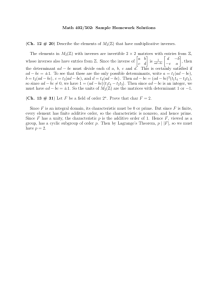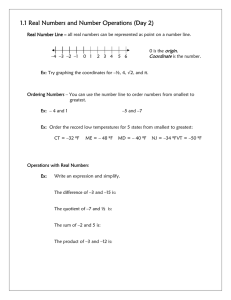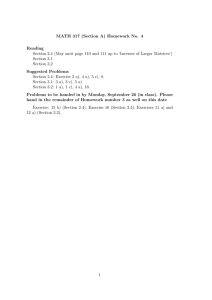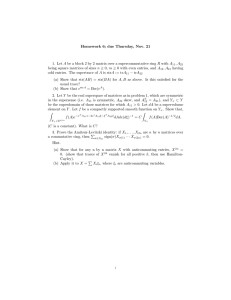MATH 113 - HOMEWORK 2 SOLUTIONS 4.8. Note that while I
advertisement
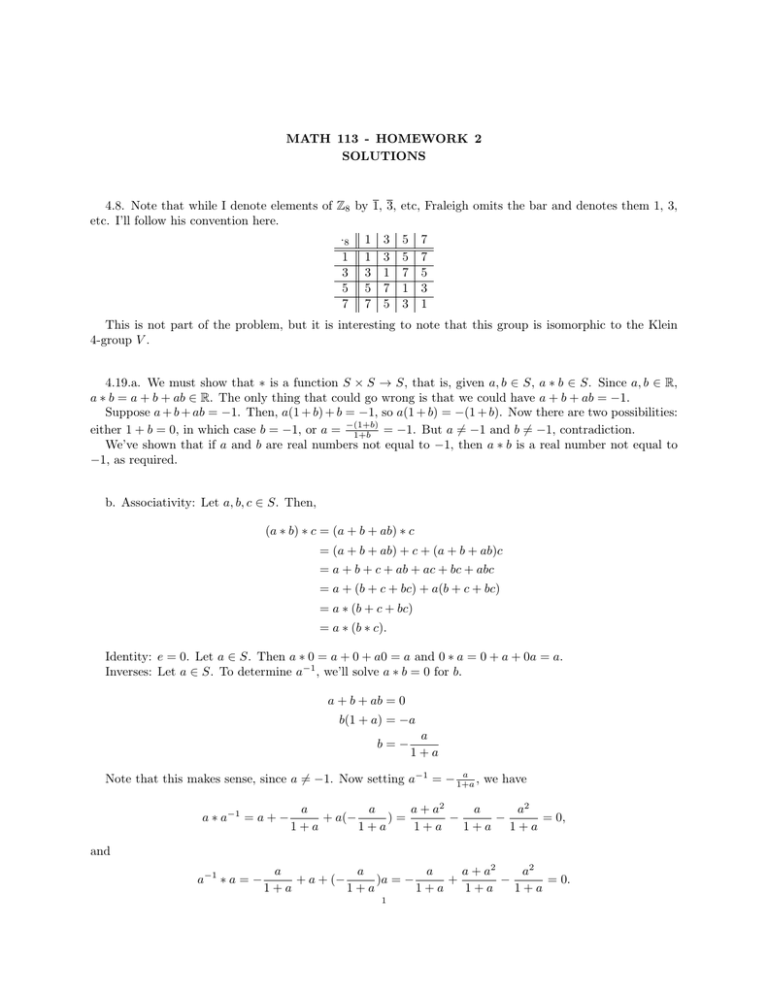
MATH 113 - HOMEWORK 2
SOLUTIONS
4.8. Note that while I denote elements of Z8 by 1, 3,
etc. I’ll follow his convention here.
·8 1 3
1 1 3
3 3 1
5 5 7
7 7 5
etc, Fraleigh omits the bar and denotes them 1, 3,
5
5
7
1
3
7
7
5
3
1
This is not part of the problem, but it is interesting to note that this group is isomorphic to the Klein
4-group V .
4.19.a. We must show that ∗ is a function S × S → S, that is, given a, b ∈ S, a ∗ b ∈ S. Since a, b ∈ R,
a ∗ b = a + b + ab ∈ R. The only thing that could go wrong is that we could have a + b + ab = −1.
Suppose a + b + ab = −1. Then, a(1 + b) + b = −1, so a(1 + b) = −(1 + b). Now there are two possibilities:
either 1 + b = 0, in which case b = −1, or a = −(1+b)
1+b = −1. But a 6= −1 and b 6= −1, contradiction.
We’ve shown that if a and b are real numbers not equal to −1, then a ∗ b is a real number not equal to
−1, as required.
b. Associativity: Let a, b, c ∈ S. Then,
(a ∗ b) ∗ c = (a + b + ab) ∗ c
= (a + b + ab) + c + (a + b + ab)c
= a + b + c + ab + ac + bc + abc
= a + (b + c + bc) + a(b + c + bc)
= a ∗ (b + c + bc)
= a ∗ (b ∗ c).
Identity: e = 0. Let a ∈ S. Then a ∗ 0 = a + 0 + a0 = a and 0 ∗ a = 0 + a + 0a = a.
Inverses: Let a ∈ S. To determine a−1 , we’ll solve a ∗ b = 0 for b.
a + b + ab = 0
b(1 + a) = −a
b=−
a
1+a
a
Note that this makes sense, since a 6= −1. Now setting a−1 = − 1+a
, we have
a ∗ a−1 = a + −
a
a
a + a2
a
a2
+ a(−
)=
−
−
= 0,
1+a
1+a
1+a
1+a 1+a
and
a−1 ∗ a = −
a
a
a
a + a2
a2
+ a + (−
)a = −
+
−
= 0.
1+a
1+a
1+a
1+a
1+a
1
c. Simplify:
2∗x∗3=7
(2 + x + 2x) ∗ 3 = 7
(2 + 3x) ∗ 3 = 7
(2 + 3x) + 3 + (2 + 3x)3 = 7
11 + 12x = 7
12x = −4
1
x=−
3
4.29. Let (G, ∗) be a finite group with an even number of elements and identity e. I claim that there is
an element a ∈ G with a−1 = a. Then we’ll be done, since a ∗ a = a ∗ a−1 = e.
Suppose for contradiction that the only element a ∈ G with a−1 = a is e. Then since for all a ∈ G,
−1 −1
(a )
= a, we can partition the non-identity elements of G into pairs {a, b} such that a−1 = b and
−1
b = a. Suppose there are k pairs. Then, since every element of G is e or fits into one of these pairs,
|G| = 2k + 1. This contradicts our assumption that the order of G is even.
4.31. Let (G, ∗) be a group with identity e. Note that e ∗ e = e, so G has at least one idempotent element.
Now suppose x ∈ G with x ∗ x = x. Multiplying by x−1 , we have x−1 ∗ x ∗ x = x−1 ∗ x, so e ∗ x = e, and
x = e. So e is the only idempotent element of G.
4.32. We have a group G such that x ∗ x = e for all x ∈ G. Let a, b ∈ G, and consider (a ∗ b) ∗ (a ∗ b) = e.
Multiplying on the left by a and on the right by b, we have a ∗ a ∗ b ∗ a ∗ b ∗ b = a ∗ e ∗ b, so e ∗ b ∗ a ∗ e = a ∗ b,
and b ∗ a = a ∗ b. So G is abelian.
4.33. We have an abelian group G. We’ll prove by induction on n ∈ Z+ that (a ∗ b)n = an ∗ bn .
Base case: n = 1. We have (a ∗ b)1 = a ∗ b = a1 ∗ b1 .
Inductive step: For n > 1, assume (a ∗ b)(n−1) = a(n−1) b(n−1) . Then (a ∗ b)n = (a ∗ b)(n−1) ∗ (a ∗ b) =
(n−1)
a
∗ b(n−1) ∗ a ∗ b = a(n−1) ∗ a ∗ b(n−1) ∗ b = an ∗ bn . Here we used commutativity to swap a and b(n−1) .
4.35. Suppose a, b ∈ G with (a ∗ b)2 = a2 ∗ b2 . Then (a ∗ b) ∗ (a ∗ b) = a ∗ a ∗ b ∗ b, so canceling an a from
the left and a b from the right, (a−1 ∗ a) ∗ b ∗ a ∗ (b ∗ b−1 ) = (a−1 ∗ a) ∗ a ∗ b ∗ (b ∗ b−1 ), and b ∗ a = a ∗ b.
5.8. No - it is not closed under matrix multiplication. If A, B are n × n matrices with determinant 2, then
AB has determinant 4.
5.9. Yes. Let S ⊆ GLn (R) be the set of diagonal n × n matrices with no zeros on the diagonal. For ease
of typesetting, I will denote an n × n diagonal matrix by a list of its diagonal entries: (a11 , a22 , . . . , ann ),
with the understanding that all off-diagonal entries are 0.
Closure: If A = (a11 , a22 , . . . , ann ) ∈ S and B = (b11 , b22 , . . . , bnn ) ∈ S, then (doing some matrix multiplication), AB = (a11 b11 , a22 b22 , . . . , ann bnn ) ∈ S, since if aii 6= 0 and bii 6= 0, then aii bii 6= 0.
Identity: The identity matrix (1, 1, . . . , 1) ∈ S.
−1
−1
Inverses: If A = (a11 , a22 , . . . , ann ) ∈ S, A−1 = (a−1
11 , a22 , . . . , ann ) ∈ S.
5.13. Yes. This subgroup of GLn (R) is denoted On (R) and is called the orthogonal group.
Closure: If A, B ∈ On (R), AT A = In and B T B = In . Then (AB)T (AB) = B T AT AB = B T In B =
T
B B = In , so AB ∈ On (R).
Identity: The identity matrix satisfies (In )T = In , so (In )T In = In In = In , and In ∈ On (R).
Inverses: Let A ∈ On (R). Note that since AT A = In , A−1 = AT . We have (A−1 )T (A−1 ) = (A−1 )T AT =
(AA−1 )T = (In )T = In . So A−1 ∈ On (R).
2
5.36.a.
+
0
1
2
3
4
5
0
0
1
2
3
4
5
1
1
2
3
4
5
0
2
2
3
4
5
0
1
3
3
4
5
0
1
2
4
4
5
0
1
2
3
5
5
0
1
2
3
4
b. h0i = {0}
h1i = {0, 1, 2, 3, 4, 5}
h2i = {0, 2, 4}
h3i = {0, 3}
h4i = {0, 2, 4}
h5i = {0, 1, 2, 3, 4, 5}
c. 1 and 5.
d. This one is a hassle to typeset, so I won’t. h0i goes at the bottom. Lines connect it to h2i = h4i and
h3i. Lines connect these two subgroups to h1i = h5i which is at the top.
5.43. We have G and abelian group and H, K ≤ G subgroups. We want to show that HK = {hk | h ∈
H and k ∈ K} is a subgroup of G.
Closure: Let a, b ∈ HK. Then a = hk and b = h0 k 0 for some h, h0 ∈ H and k, k 0 ∈ K. Now ab = hkh0 k 0 =
0
hh kk 0 = (hh0 )(kk 0 ) ∈ HK, since hh0 ∈ H and kk 0 ∈ K.
Identity: e ∈ H and e ∈ K, so e = ee ∈ HK.
Inverses: Let a ∈ HK. Then a = hk for some h ∈ H and k ∈ K. Now a−1 = (hk)−1 = k −1 h−1 =
−1 −1
h k ∈ HK, since h−1 ∈ H and k −1 ∈ K.
5.49. We have a ∈ G, where G is a finite group. Consider the set of positive powers of a: {an | n ∈
Z } ⊆ G. Since G is finite, these powers cannot all be distinct. We must have an = am for some n, m ∈ Z+ .
Without loss of generality, take n < m, so (m − n) ∈ Z+ . Then canceling n powers of a from both sides,
a−n an = a−n am , so e = am−n , as desired.
+
5.50. We have a group G and a nonempty finite subset H ⊆ G which is closed under the binary operation
of G. The claim is that H ≤ G.
Closure: This is the assumption on H.
Identity: H is nonempty, so we can choose some a ∈ H. Since H is closed under the group operation, we
have {an | n ∈ Z+ } ⊆ H. Now just as in Exercise 5.49, since H is finite, we must have an = am for some
n < m. Then am−n = e, and m − n ∈ Z+ , so e = am−n ∈ H.
Inverses: Let a ∈ H. By the same argument as above, there is k ∈ Z+ such that ak = e.
Case 1: k = 1. Then a = e and a−1 = a ∈ H.
Case 2: k > 1. Then aak−1 = ak = e, so a−1 = ak−1 . Since a ∈ H and k − 1 > 0, ak−1 ∈ H.
3




